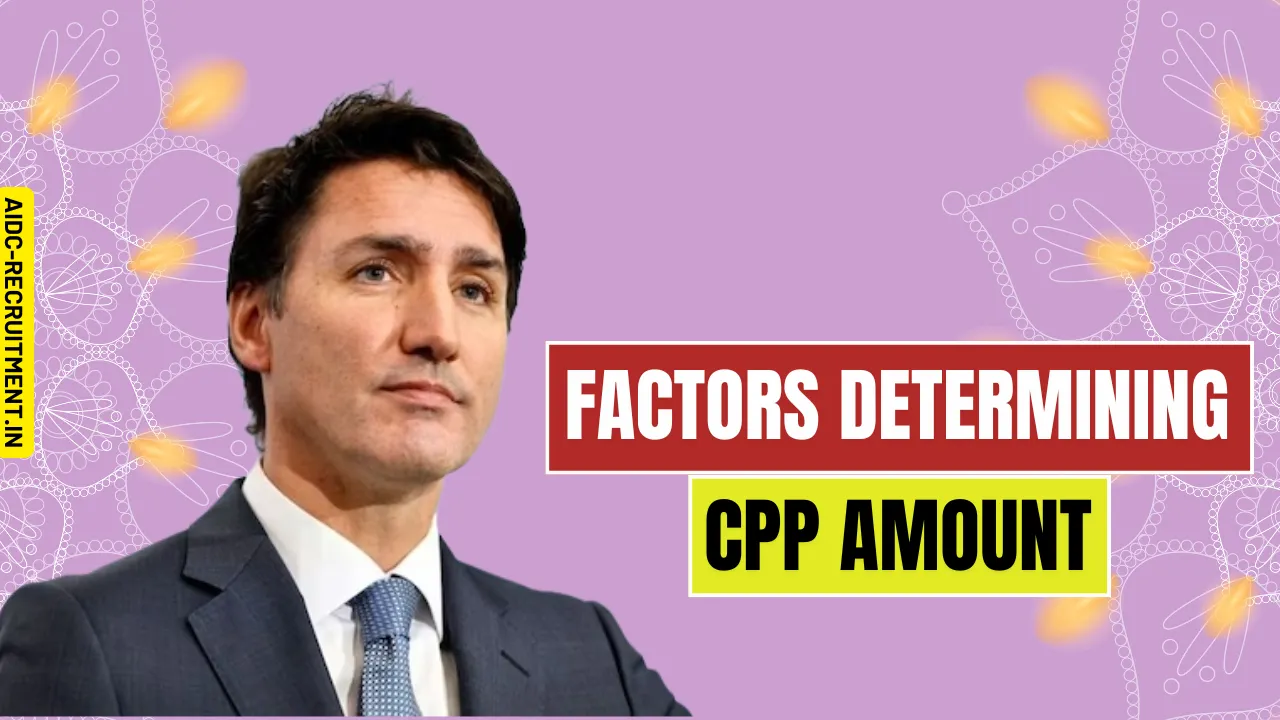Factors Determining CPP Amount: The Canada Pension Plan (CPP) is a critical component of retirement income for many Canadians. Designed to provide financial security during retirement, CPP benefits are based on contributions made throughout your working years. Whether you are nearing retirement or planning ahead, understanding the factors that determine your CPP amount after retirement is crucial for financial stability.
This article explores the key determinants of CPP benefits, eligibility requirements, application process, and tips for maximizing your retirement income.
Overview of CPP Amount After Retirement
| Details | Information |
| Eligibility Age | Between 60 and 70 years |
| Maximum Monthly Payment (2025) | $1,364.60 |
| Average Monthly Payment (2025) | $816.52 |
| Contribution Rate | 5.95% for employees; 11.9% for self-employed |
| Application Method | Online through the My Service Canada Account |
| Adjustment for Delays | 0.7% increase per month for deferring benefits after 65 |
What Is the Canada Pension Plan (CPP)?
The Canada Pension Plan (CPP) is a government-administered social security program that provides monthly retirement income to contributors. Funded by employee and employer contributions, CPP ensures a reliable income stream for retirees, helping them cover basic expenses and maintain financial independence.
The program is indexed to inflation, meaning the benefit amount adjusts annually to keep up with the rising cost of living. This makes CPP a dependable source of retirement income.
Factors That Determine CPP Amount
Several factors influence how much you’ll receive in CPP benefits after retirement. These include your age, contributions, and decisions about when to start receiving payments.
1. Age When Benefits Start
The age at which you decide to start receiving CPP benefits significantly impacts the amount you’ll receive:
- Early Start (60–64):
- Starting early reduces your monthly payment by 0.6% per month before age 65, up to a total reduction of 36%.
- Example: If your eligible benefit at 65 is $1,000 per month, starting at 60 reduces it to $640.
- Standard Start (65):
- If you start at age 65, you’ll receive the full amount based on your contributions.
- Delayed Start (66–70):
- Delaying CPP increases your payment by 0.7% per month after age 65, up to a total increase of 42% by age 70.
- Example: If your eligible benefit is $1,000 at 65, waiting until 70 increases it to $1,420.
2. Contributions During Employment
The amount you contribute to CPP during your working years plays a major role in determining your retirement benefits:
- Contribution Rate:
- Employees contribute 5.95% of their earnings annually, up to the yearly maximum pensionable earnings (YMPE). Employers match this contribution.
- Self-employed individuals pay the combined total of 11.9%.
- Maximum Contribution:
- In 2023, the YMPE was $66,600, meaning contributions were capped at this income level. Higher contributions lead to higher benefits.
3. Post-Retirement Contributions
If you continue working after you start receiving CPP benefits (between 60 and 70), you can contribute to the Post-Retirement Benefit (PRB):
- Each year of contributions adds a small increase to your monthly CPP payment.
- PRB is an excellent option for those who start benefits early but continue earning income.
4. Inflation Adjustments
CPP payments are indexed annually based on the Consumer Price Index (CPI). This ensures your benefits retain their purchasing power despite inflation.
How Much CPP Will You Get?
The exact amount you’ll receive depends on your earnings history, contributions, and the age you start receiving benefits.
CPP Payment Breakdown for 2025
| Type of Benefit | Average Monthly Payment | Maximum Monthly Payment |
| Retirement Pension (at 65) | $816.52 | $1,364.60 |
| Post-Retirement Benefit (at 65) | $21.43 | $44.46 |
The table reflects the average amounts based on recent data. Individuals with consistent contributions near the maximum level are more likely to receive higher payouts.
Who Is Eligible for CPP?
To qualify for CPP benefits, individuals must meet specific eligibility criteria.
Key Requirements
- Age:
- You can apply for CPP as early as 60 years old or delay it until 70 years old.
- Residency:
- You must be a Canadian citizen or permanent resident.
- Contributions:
- CPP eligibility requires sufficient contributions during your working years. Contributions are based on employment income or self-employment earnings.
- Other Pension Benefits:
- Individuals receiving benefits from the Quebec Pension Plan (QPP) or other retirement programs may still qualify for CPP, but adjustments may apply.
How to Apply for CPP
Applying for CPP is straightforward, and early preparation ensures timely processing.
Steps to Apply
- Check Your Eligibility:
- Use the My Service Canada Account portal to verify your eligibility and contribution history.
- Gather Documents:
- Have your Social Insurance Number (SIN), proof of identity, and banking details for direct deposit.
- Complete the Application Online:
- Visit the CRA’s official website to fill out the application.
- Submit Your Application:
- Double-check your application for errors before submission. Attach all required documents.
- Receive Confirmation:
- Applications are typically processed within 7–14 days, and payments will begin shortly after approval.
Tips to Maximize Your CPP Benefits
1. Start at the Right Time
Consider your financial situation and health when deciding whether to start CPP early, on time, or delay it. Waiting until 70 can significantly boost your monthly income.
2. Contribute Consistently
Aim to contribute regularly to the CPP, especially up to the YMPE limit, to maximize your benefit amount.
3. Continue Working After Retirement
If feasible, contribute to the Post-Retirement Benefit (PRB) to increase your monthly payments.
4. Track Your Contributions
Regularly review your CPP contributions using the My Service Canada Account portal to ensure all earnings are accounted for.
Frequently Asked Questions
Is CPP taxable?
Yes, CPP benefits are considered taxable income and must be reported when filing taxes.
Can spouses split CPP benefits?
Yes, CPP benefits can be shared between spouses or common-law partners to reduce tax liability and balance retirement income.
What happens if I don’t contribute consistently?
Inconsistent contributions will lower your CPP benefit, as payouts are calculated based on your earnings and contributions.
Are there changes to CPP in 2025?
Yes, contribution rates remain at 5.95%, and payouts are adjusted annually for inflation to reflect changes in the Consumer Price Index.
Conclusion
Your CPP amount after retirement is determined by a combination of factors, including your contributions, the age at which you start benefits, and whether you continue working post-retirement. By understanding these variables and planning ahead, you can make informed decisions to optimize your retirement income.
For detailed information on your CPP benefits and to track your contributions, visit the My Service Canada Account portal or the official government website. Taking proactive steps today can ensure financial security and peace of mind in your golden years.












